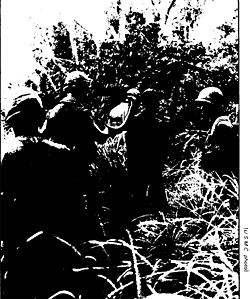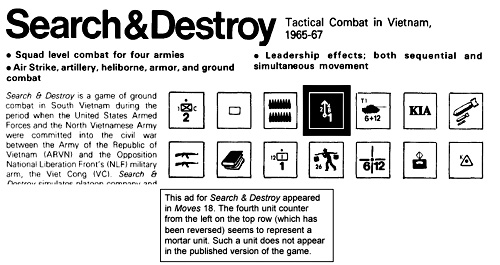
Search & Destroy
Tactical Combat Vietnam: 1965-1966Designed by John Michael Young
Published by SPI, 1975
Introduction
Search & Destroy is a squad level simulation of typical tactical combat between American and/or ARVN and North Vietnamese and/or Viet Cong units in the period 1965-67 in Vietnam. Search & Destroy is basically an extension and update of SPI’s Grunt game, which appeared in S&T 26 in 1971. Players 2Playing Time 2 to 3 hours
Era Modern: Vietnam War
Scale Tactical
Time unidentified (max. 15 turns)
Space 1 hex = 50 meters Units each unit represents a squad of 6 to 12 men
Components
1 Unmounted 22"x34½" hex-based two-color map 1 16-page 8½"x11" rulebook 400 single-sided die-cut two-color counters 1 Standard SPI 3/8" white six-sided die 1 Standard SPI plastic tray with three-color cover sheetCounter Manifest
USA (black on green)10 AFV (4 tanks; 6 APCs)
5 Battalion Commanders
5 Forward Observers
10 Ammo supply markers
10 Improved position markers
23 Point of Impact markers (10 artillery; 9 air strike; 4 tank)
20 PIN markers
20 WIA markers
12 KIA markers
1 Game turn marker
USA (white on green)
26 Infantry squads (22 2-strength; 4 1-strength)
11 Commanders (1 Battalion; 2 Company; 8 platoon)
1 Medical team
ARVN (black on dark green)
2 Rangers
2 Intelligence
Markers (white with black border on green)
2 five-pointed stars
NLF (white on black)
27 NVA squads
9 VC militia
3 Snipers
12 Peasants
6 Porters
10 Commanders (1 company & 9 squad)
14 Dummy units
10 Blanks
20 Cache markers (4 arms; 8 ammo; 8 rice)
1 Radio
2 Administrative records
8 Mines (4 AT and 4 anti-personnel)
15 Ambush markers
25 Improved position markers
25 PIN markers
20 KIA markers
20 WIA markers (green on black)
2 five-pointed stars
Of the 240 NLF counters in the game, my copy had only 229, as noted in the above manifest. Although my copy also contained the sheet from which the counters were punched, the best I could determine was that the 11 missing counters were NLF forces.
What the reviewers say:
“Search & Destroy is a significant step forward in the art of conflict simulation. The revolutionary step-by-step rules system, whereby the Players decide the precise amount of complexity desired, is a logical and excellently developed sequel to the Optional Rules system long in use. In addition, many ideas developed for Grunt and expanded and improved for Search & Destroy are quite unknown elsewhere and accurately tell the tactical tale of what is probably the most unusual, and certainly the most tragic, war of the 20th Century.” Phil Kosnett in Moves 23.“Search & Destroy/Grunt was a unique introduction to the reality of small-unit command. It does not give much detail on combat. There are no complicated combat routines, or extensive weapons tables here. Instead, players have to be concerned about real command problems: coordinating artillery/air support, medevacs, resupply under fire, intelligence, and all those darned civilians who keep getting in the way. Rules are obvious and logical, for the most part, and the game is, like real small-unit command, both frustrating and rewarding.” Joe Miranda in Moves 71.
“Search & Destroy never did well on the SPI Game Ratings Chart (it reached a high of 5.87 in S&T #50). But in my opinion this is one of the finest games on the subject still in print.” Rodger MacGowan in F&M 18.
“S&D is a unique game in that it makes the players feel as if they are in command of a rifle company or Viet Cong company and goes beyond a strictly military interpretation of war to take into account the political consequences of small unit actions and how they fit into a national strategy. It, like the real war, leaves the players with frustrating choices based on limited information made under difficult circumstances. This uncertainty makes for tense contests that are seldon decided until the final turn. So if you desire complete knowledge of your opponent’s forces, lots of unrestricted unrestricted firepower, boffo gadgets, and no decisions that are more complex than where to move and when to fire then do not play S&D. However, if you are looking for an intellectually challenging simulation of simulation of company level combat that will let you feel the same anxiety and face the same problems as the real commanders did, find a copy of S&D. You will not be disappointed.” N.Stasnopolis in F&M 73.
“Revision of Grunt game, with some major changes. Vietnam in the ‘60’s; squad level mobile actions; NLF units hidden; air strikes; heliborne operations; medical evacuation; sequential or SiMove; multitude of counter types; varied optionals; turn equivalent minutes; fairly complex, length varies.” Richard Berg in S&T 48.
“It is an interesting and fairly playable game about the early years of the U.S. involvement in Vietnam. However, I cannot recommend it for all gamers. It is a specialized type of game that will have only a limited appeal. One thing that will prevent it from achieving wide popularity is the victory conditions. First, because of the historical game situation, the victory conditions, especially in some of the Advanced Rules, have a heavy political overtone. This makes the game realistic, but less fun for many gamers, I think. Second, the U.S. player gets a large portion of his victory points by capturing rice caches and administrative records. This is not quite as exciting as trying to capture Moscow or even having to destroy 4 Tiger tank platoons to win. ...
Also, the game is extremely frustrating for the U.S. player. He is very seldom sure what he is shooting at or where he will be shot at from. It can be pretty aggravating to lose a game just because you accidentally killed a peasant unit on the last turn. But Vietnam was that way, and so must the game be. Howecver, I do think that Search & Destroy has great appeal for some wargamers: the historians.” Pat Allen in Panzerfaust 69.
Collector’s Value
Search & Destroy, like its predecessor, Grunt, was not a popular game with the board wargamers of the time. Pat Allen’s comments from 1975 may sound ironic to us now, but are unfortunately close to the truth ... it was not a war game, dammit! Boone lists low, high and average prices of 7/30/15.20 at auction and 10/50/26.42 for sale.Other games by this designer
Austerlitz; Borodino; Dreadnought; Fall of Rome; La Grande Armee; Lee Moves North; the Marne; Musket & Pike; PRESTAGS (Chariot; Legion; Phalanx; Viking; Yeoman); Seelowe; Spartan; Strategy I; and Wilderness Campaign (all SPI).With John Young’s premature death, the hobby lost a talented and prolific designer.
Other games of this type
Grunt (SPI).Errata
(courtesy Alan R. Arvold) Hexsides common to only one blocking terrain hex do not block the line of sight if the line of sight longitudinally bisects the hexside. If the line of sight bisects the intersection of hexsides common to both blocking terrain hexes and non-blocking terrain hexes then the line of sight is not blocked at that point.Units which start the game set up on the board may be considered to be in or not in improved positions at the owning player’s discretion. Units that are in improved positions need not have the improved position marker placed on top of them on the board until they have been spotted in any manner by enemy units. The fact that a unit is in improved positions must be recorded on a sheet of paper. Record the unit and hex number of the hex it is in.
[19.21] Third sentance should read as S&D continued from page 49 follows: Once you are “out of ammo”, you can no longer fire, though NLF units reaching an NLF Ammunition Cache and US units reaching a supply unit, may resupply.
The US player may call in as many Ammunition Supply Counters as he desires per turn. (He has in game terms an unlimited supply.) Only one Supply Counter may be in a hex at any one time. The counter may be placed in any hex. All squads and Leadership counters which have a printed combat strength on them are eliminated from the game when they receive six casualties or more. All leadership counters that have no printed numerical strength on them are eliminated after receiving two casualties. US Medic and NLF Porter units may carry up to a maximum of four WIA or two KIA or one KIA and two WIA casualties. US and NLF squad size units may carry up to twelve KIA and/or WIA in any combination.
All Enemy and Friendly personnel units are attacked in the effected hexes.
The Artillery Strike Pattern diagram should have a North Arrow pointing up next to it and should have the Artillery Center of Impact counter in it. The Tank HE Fire diagram should have the Tank HE Center of Impact counter in it.
The Artillery Strike Pattern is set up on the Game Map in relation to the North Arrow on the map, not to the point of view of the Forward Observer unit calling in the fire.
Air Strike Patterns may be of any shape providing the hexes are in contact with each other on at least two sides (i.e. each hex is adjacent to at least two other strike hexes) and it is in a contiguous pattern (i.e. no unaffected hexes in the middle of the pattern).
The US Player can only kill a peasant on the second attempt if the peasant is already a wounded casualty and the US Player gets a Peasant Wounded result.
[23.15] Last two sentances should read: If the second result is “Peasant Wounded”, then the Porter can be considered as eliminated by interrogation. The NLF Player receives ten Victory Points if the Porter is wounded or fifteen Victory Points if the Porter is killed.
[23.3] Interrogation Results Table Explanation of Results: A = Located one Ammo Cache.
There are three NLF Leader(cadre) counters in a VC Company, not two. There are also three additional NLF Leader counters as Company Commanders. Each has an Attack Strength of 2. (The companies are labeled as 1st, 2nd, and 3rd Companies.) There is one company size NLF Leader in a Mixed Company, a VC Company, and an NVA Company. There are three company size NLF Leaders in an NVA Battalion. These leader counters follow the same rules as other NLF Leader counters. In all cases these are in addition to the number of NLF Leaders listed on the chart.
Helecopter counters are available to mark the hexes where the various types of helecopters are on the mapboard.
Khuen Phuong Province Scenario:
NLF Player Forces Deployment: enter anywhere on the east map edge on Game Turn One. Move first.
US Player Forces Deployment: helidrops on the first Game-Turn in the normal manner. Move second.

Back to Simulacrum Vol. 4 No. 2 Table of Contents
Back to Simulacrum List of Issues
Back to MagWeb Master Magazine List
© Copyright 2002 by Steambubble Graphics
This article appears in MagWeb (Magazine Web) on the Internet World Wide Web. Other military history articles and gaming articles are available at http://www.magweb.com